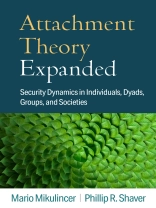From pioneering attachment researchers, this book takes an expansive look at the nature and functions of security dynamics in personal and social relationships. Mario Mikulincer and Phillip R. Shaver examine how attachment operates not only in close dyadic relationships (parent–child, romantic partners), but also between teachers and students, therapists and clients, physicians and patients, leaders and followers, and within organizations. Also considered is the nature of ‘attachments’ to objects; commercial brands; substances, such as foods and drugs; and places. The book highlights ways to integrate attachment theory with other influential social and psychological theories concerning factors that enable individuals, groups, and societies to flourish despite inevitable threats, conflicts, and losses.
See also the related work from Mikulincer and Shaver, Attachment Theory Applied: Fostering Personal Growth through Healthy Relationships.
Tabla de materias
I. Attachment Theory: Its Original Version and Our Expansion of It
1. Attachment Theory and Security Dynamics
2. An Outline of the Expanded Theory
3. The Expanded Theory in Relation to Other Social-Psychological Theories
II. Seeking and Attaining Felt Security: The Distress−Relief Cycle Involving Proximity Seeking and Others’ Responsiveness
4. Facing Threats and Challenges: Seeking a Safe Haven and Secure Base for Exploration
5. A Cost of Becoming Attached: Facing the Threat of Attachment-Figure Unavailability
6. Feeling Protected and Supported: Calming and Empowering Effects
7. Feeling Protected and Supported: Security-Enhancing Effects
III. Intrapersonal, Relational, and Societal Implications of Attaining or Failing to Attain Security
8. The Broaden-and-Build Effects of Felt Security: Resilience, Subjective Well-Being, and Mental Health
9. The Broaden-and-Build Effects of Felt Security: Mature, Other-Oriented Love
10. The Broaden-and-Build Effects of Felt Security: Personal Growth and Autonomous Relatedness
11. Thwarted Security and the Development of Anxious and Avoidant Patterns of Self-Regulation and Relating
IV. Epilogue
12. Wrapping Up, Taking Stock
Appendices
References
Index
Sobre el autor
Mario Mikulincer, Ph D, is Professor of Psychology and Founding Dean of the Baruch Ivcher School of Psychology at Reichman University in Israel. His research interests include attachment processes in adulthood, terror management theory, personality processes in interpersonal relationships, evolutionary psychology, human learned helplessness and depression, trauma and posttraumatic processes, and coping with stress. Dr. Mikulincer is a Fellow of the Association for Psychological Science and the Society for Personality and Social Psychology. He is a recipient of Israel’s EMET Prize for Art, Science, and Culture and of the Berscheid–Hatfield Award for Distinguished Mid-Career Achievement from the International Association for Relationship Research.
Phillip R. Shaver, Ph D, is Distinguished Professor Emeritus of Psychology at the University of California, Davis. He has published numerous books, including Handbook of Attachment, and over 400 journal articles and book chapters. Dr. Shaver’s research focuses on attachment, human motivation and emotion, close relationships, personality development, and the effects of meditation on behavior and brain. He is a Fellow of the American Psychological Association and the Association for Psychological Science and is past president of the International Association for Relationship Research, from which he received the Distinguished Career Award. He has also received an honorary doctorate from Stockholm University and Distinguished Career Awards from the Society of Experimental Social Psychology and the Society for Personality and Social Psychology. He is an elected member of the American Academy of Arts and Sciences.












